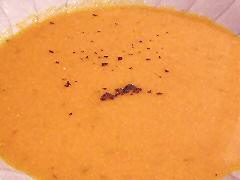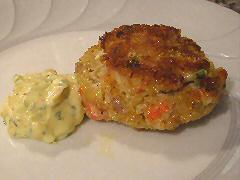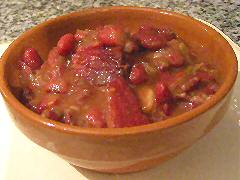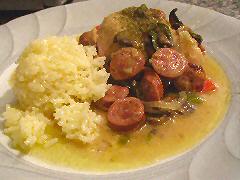“Cajun is country food by farmers and fisherman that arrived in Louisiana from Acadiana, Canada…. Creole is New Orleans city food. Communities were created by the people who wanted to stay and not go back to Spain or France.”
– Paul Prudhomme, Chef
Buenos Aires – You’d think, given the constant harping about lack of spiced food that goes on amongst us folk in the expat community here, that the offer of a weekend of cajun and creole cooking would have filled up faster than Justin Wilson could have said “I gar-on-tee!” And Friday eve packed with reservations almost immediately, though there was a bit of give and take after that as folks changed around schedules. Not a one for Saturday, and only a trio for Sunday, whom, unfortunately, we decided to cancel on without any additional folk coming. I know it was Mothers’ Day here on Sunday, but not every expat in town was out feting dear old Mom. And it’s not even a cuisine I was just experimenting with – during a part of my past I was sous chef at The Sazerac House in New York, which while not turning out the most authentic Louisiana cuisine out there, I think we did a decent job, and it gave me a good exposure to the flavors involved. Such is life – the same thing seems to be happening with an Indian dinner coming up this weekend, while meanwhile, the following week, with a promise of cooking from the region around Paris, filled up weeks ago – go figure – maybe I’ll do spicy Parisian food and trick them all…
Now the first thing, there’s not just one cuisine of the state – which we were celebrating because this weekend was the anniversary of the ratification by Congress of the Louisiana Purchase – as noted above in the quote from Chef Paul Prudhomme, one of the deans of the cuisine. And it’s not all universally picante – what there is is a depth of flavor that comes from a lot of slow cooked dishes, where spices and herbs meld together to form complexities that can be quite subtle. And then, of course, there can be those quick cooked, multi-spiced things like the famed “blackened redfish”, that literally cooks in a mere minute or two over searingly high heat, crisping spice mixtures right into the surface (that was out for this weekend – you need high intensity heat under cast iron, to the point where the metal is actually changing color, and you need enough space to put each piece of meat or fish into the pan without cooling the whole thing down – I just don’t have that much room).
 I wanted to start out at the non-spicy end and work my way up – so we began the evening with a chilled Creole Tomato Soup. My guess, given the ingredients that go into this, is this derives from some of the Spanish population that settled in parts of the New Orleans area. It’s actually a really simple soup to make, and can be eaten hot when just cooked – but I recommend letting it cool and then chilling, as something changes in the flavor profile that really makes this soup shine. Saute a few sliced garlic cloves in olive oil for about 2-3 minutes, just to flavor the oil well. Add a chopped red bell pepper, and if you can, a chopped ancho pepper or two (if not available, like here, use a teaspoon or two of ancho chili powder). Cook until the peppers soften, 3-4 minutes. Add a whole lot of tomatoes (I probably used about 4 pounds), simply cut into pieces – depending on their size, 4-8 pieces, and a good splash of sherry vinegar (¼ cup, more or less). Cover the pot, bring the whole mixture up to a simmer (no water needs to be added, the tomatoes will release enough liquid), then turn the heat down and leave it to simmer away for about 15-20 minutes, until the tomatoes are all soft and cooked through. Remove from the heat, and then puree in a blender with a handful of thyme and basil leaves. Season with salt and black pepper. Let cool, then chill for several hours. Re-season – remember that spices, while they’ll meld well during the chilling process, will also become a bit muted. If it needs a little more acidity, add some more sherry vinegar. I garnished the soup with some black olive crumbs.
I wanted to start out at the non-spicy end and work my way up – so we began the evening with a chilled Creole Tomato Soup. My guess, given the ingredients that go into this, is this derives from some of the Spanish population that settled in parts of the New Orleans area. It’s actually a really simple soup to make, and can be eaten hot when just cooked – but I recommend letting it cool and then chilling, as something changes in the flavor profile that really makes this soup shine. Saute a few sliced garlic cloves in olive oil for about 2-3 minutes, just to flavor the oil well. Add a chopped red bell pepper, and if you can, a chopped ancho pepper or two (if not available, like here, use a teaspoon or two of ancho chili powder). Cook until the peppers soften, 3-4 minutes. Add a whole lot of tomatoes (I probably used about 4 pounds), simply cut into pieces – depending on their size, 4-8 pieces, and a good splash of sherry vinegar (¼ cup, more or less). Cover the pot, bring the whole mixture up to a simmer (no water needs to be added, the tomatoes will release enough liquid), then turn the heat down and leave it to simmer away for about 15-20 minutes, until the tomatoes are all soft and cooked through. Remove from the heat, and then puree in a blender with a handful of thyme and basil leaves. Season with salt and black pepper. Let cool, then chill for several hours. Re-season – remember that spices, while they’ll meld well during the chilling process, will also become a bit muted. If it needs a little more acidity, add some more sherry vinegar. I garnished the soup with some black olive crumbs.
 One reviewer of the Sazerac House, back in the day (the place closed last year after a nearly four decade run), said that the crabcakes “stopped by heaven” on their way to your plate. They’re still pretty much the best crabcakes I’ve ever had, and I’m always thrilled that I have the recipe in my repertoire. I even served a “kosher” version of them for my dad’s 60th birthday party a few years back, using surimi instead of crab, and people raved about them. Now, here’s the thing, it’s not really my recipe to give out, at least in detail – I just wouldn’t feel right about that without getting Barry and Dierdre’s permission – perhaps one day. But here’s the thing – there are a couple of key things – lots of crabmeat and not a lot of filler. One of the problems at most places I’ve had crabcakes is that they may as well be breadcrumb cakes with crab flavoring. Now, they didn’t turn out perfectly here – the crab that’s available is different, I had to settle for frozen centolla, or spider crab, meat – just not that same lump crab meat from blue crabs. Also, no scallions – even in Chinatown for some reason, where I usually can find them – so green onions. And, no real Old Bay Spice, though I have worked up an acceptable subsitute spice mixture. The cakes themselves – a mix of, I repeat, lots of crabmeat, just enough mayo to bind it together, chopped scallions or green onions, Old Bay, Tabasco, Worcestershire, and, like the mayo, just enough breadcrumbs to give the cakes a little bit firmer texture. Then the mixture is formed into patties and rolled in breadcrumbs to form the crust. To cook, they’re sauteed in a mix of 50:50 neutral oil and butter (peanut oil is best if no one has an allergy to it), until they’re golden brown on each side. They get served up with homemade tartar sauce.
One reviewer of the Sazerac House, back in the day (the place closed last year after a nearly four decade run), said that the crabcakes “stopped by heaven” on their way to your plate. They’re still pretty much the best crabcakes I’ve ever had, and I’m always thrilled that I have the recipe in my repertoire. I even served a “kosher” version of them for my dad’s 60th birthday party a few years back, using surimi instead of crab, and people raved about them. Now, here’s the thing, it’s not really my recipe to give out, at least in detail – I just wouldn’t feel right about that without getting Barry and Dierdre’s permission – perhaps one day. But here’s the thing – there are a couple of key things – lots of crabmeat and not a lot of filler. One of the problems at most places I’ve had crabcakes is that they may as well be breadcrumb cakes with crab flavoring. Now, they didn’t turn out perfectly here – the crab that’s available is different, I had to settle for frozen centolla, or spider crab, meat – just not that same lump crab meat from blue crabs. Also, no scallions – even in Chinatown for some reason, where I usually can find them – so green onions. And, no real Old Bay Spice, though I have worked up an acceptable subsitute spice mixture. The cakes themselves – a mix of, I repeat, lots of crabmeat, just enough mayo to bind it together, chopped scallions or green onions, Old Bay, Tabasco, Worcestershire, and, like the mayo, just enough breadcrumbs to give the cakes a little bit firmer texture. Then the mixture is formed into patties and rolled in breadcrumbs to form the crust. To cook, they’re sauteed in a mix of 50:50 neutral oil and butter (peanut oil is best if no one has an allergy to it), until they’re golden brown on each side. They get served up with homemade tartar sauce.
So let’s see – tartar sauce… mayo, preferably freshly made, mixed with dijon mustard, chopped parsley, chopped dill pickles, and a little chopped ginger, salt, and white pepper to taste. Old Bay seasoning – you can find a variety of versions of substitutions out there on the ‘net – I like to start with a base of equal parts of salt and dry mustard powder, then about half those amounts of celery seed, paprika, black pepper, and bay leaf, and then just touches of clove, allspice, ginger, cardamom, cinnamon, and nutmeg. Grind it all together to get a very fine powder. I won’t claim you can’t tell the difference from Old Bay, but it’s close enough to work in dishes that use the mixture.
 Maybe it was the concern about lack of traditional ingredients… after all, folks here know I wasn’t going to find tasso or andouille, right? But you know what, you can always work it out. For tasso, which is a spiced and smoked ham, I went out and found a butcher who had a nice supply of smoked fresh ham. Then I took that ham and rubbed it all over with salt, smoked paprika and cayenne, and let it sit for a day. To make relatively traditional cajun red beans and rice, I sauteed chopped celery, onion, and green bell pepper in oil until soft, then added the “tasso”, cut in small pieces, and cooked that until the meat was just starting to brown. At that point, I added a good amount of dry red beans (not soaked – I don’t know why, but this dish works out better when the beans aren’t pre-soaked, maybe because they absorb more flavors as they cook rather than water). Topped it all off with water, brought it to a boil, reduced the heat to a full simmer, covered the pan, and let it go for about four hours, stirring occasionally (add more water if necessary). When the beans are cooked through, adjust the seasoning with salt (note, I didn’t put any salt into the mix while the beans were cooking as it toughens their skins) and cayenne to the spiciness you want. Serve over rice.
Maybe it was the concern about lack of traditional ingredients… after all, folks here know I wasn’t going to find tasso or andouille, right? But you know what, you can always work it out. For tasso, which is a spiced and smoked ham, I went out and found a butcher who had a nice supply of smoked fresh ham. Then I took that ham and rubbed it all over with salt, smoked paprika and cayenne, and let it sit for a day. To make relatively traditional cajun red beans and rice, I sauteed chopped celery, onion, and green bell pepper in oil until soft, then added the “tasso”, cut in small pieces, and cooked that until the meat was just starting to brown. At that point, I added a good amount of dry red beans (not soaked – I don’t know why, but this dish works out better when the beans aren’t pre-soaked, maybe because they absorb more flavors as they cook rather than water). Topped it all off with water, brought it to a boil, reduced the heat to a full simmer, covered the pan, and let it go for about four hours, stirring occasionally (add more water if necessary). When the beans are cooked through, adjust the seasoning with salt (note, I didn’t put any salt into the mix while the beans were cooking as it toughens their skins) and cayenne to the spiciness you want. Serve over rice.
 Okay, gumbo. Let me just say upfront that I’ve heard all the arguments about what goes into it, how to thicken it, and everything else under the sun. Given my “druthers”, I’d thicken with a nice red roux and some sliced okra, and finish with a little filé powder – the trio of thickening agents. But, it was not to be – okra isn’t in season yet, and although I think of it as a pretty key ingredient, you can make gumbo without it (except, of course, in the opinion of the folk who say you can’t because gumbo means okra and okra means gumbo… such is the way things go sometimes). First, a roux – equal parts of oil and flour, cooked, stirring regularly, over very low heat, until the flour has browned – actually turning a sort of reddish brown color, hence “red roux” versus a blond roux – the latter only cooked for about 15 minutes or so, a red one taking well over an hour to get the color right – I’d guess mine went about an hour and a half before I decided it was ready. To that, I added a mix of red and green bell peppers, white and green onions, all chopped, salt and cayenne, and cooked them in the mixture until they were soft. Then, some andouille – well, the closest I could find here, which turned out to be some smoked, hot pepper German sausages that a butcher put together for me – a little more like a midwest style “red hot” than an andouille, but they had a great flavor. I also added a couple handfuls of chopped mushrooms, I like them in a gumbo – another thing not everyone would agree with. When this whole mixture is cooked down well, the mushrooms having released their liquid, I added the chicken pieces and just a little water, enough to be able to submerge the chicken pieces but not enough to make it a soup. Covered the pot and cooked, stirring occasionally, until the chicken was pretty much falling off the bone, a couple of hours. Season with salt and cayenne if needed, and serve with rice.
Okay, gumbo. Let me just say upfront that I’ve heard all the arguments about what goes into it, how to thicken it, and everything else under the sun. Given my “druthers”, I’d thicken with a nice red roux and some sliced okra, and finish with a little filé powder – the trio of thickening agents. But, it was not to be – okra isn’t in season yet, and although I think of it as a pretty key ingredient, you can make gumbo without it (except, of course, in the opinion of the folk who say you can’t because gumbo means okra and okra means gumbo… such is the way things go sometimes). First, a roux – equal parts of oil and flour, cooked, stirring regularly, over very low heat, until the flour has browned – actually turning a sort of reddish brown color, hence “red roux” versus a blond roux – the latter only cooked for about 15 minutes or so, a red one taking well over an hour to get the color right – I’d guess mine went about an hour and a half before I decided it was ready. To that, I added a mix of red and green bell peppers, white and green onions, all chopped, salt and cayenne, and cooked them in the mixture until they were soft. Then, some andouille – well, the closest I could find here, which turned out to be some smoked, hot pepper German sausages that a butcher put together for me – a little more like a midwest style “red hot” than an andouille, but they had a great flavor. I also added a couple handfuls of chopped mushrooms, I like them in a gumbo – another thing not everyone would agree with. When this whole mixture is cooked down well, the mushrooms having released their liquid, I added the chicken pieces and just a little water, enough to be able to submerge the chicken pieces but not enough to make it a soup. Covered the pot and cooked, stirring occasionally, until the chicken was pretty much falling off the bone, a couple of hours. Season with salt and cayenne if needed, and serve with rice.
 Finally, dessert, and a good old New Orleans style bread pudding. Leftover bread is the key – depending on who you talk to, either completely dried out or just a day or two old stale – I like the latter better. Cut in small cubes and soak in a basic custard mixture made from cream, vanilla, eggs, sugar, cinnamon, and nutmeg. I let the mixture soak for only about half an hour – some folks like to let it sit for several hours, but I find the texture turns too pudding-like as opposed to bread-like… it’s a matter of personal preference. Butter a casserole pan and pour the mixture into it, packing it in well, making sure to fill the corners and get it all fairly even. Then cover with foil and cook at about 250°F for 2 hours, remove the foil, turn the heat up to 300°F and cook another hour until the top has browned nicely. Let cool… I like to serve it just slightly warm… with whiskey sauce – cream thickened with cornstarch and then flavored with vanilla, bourbon, and sugar.
Finally, dessert, and a good old New Orleans style bread pudding. Leftover bread is the key – depending on who you talk to, either completely dried out or just a day or two old stale – I like the latter better. Cut in small cubes and soak in a basic custard mixture made from cream, vanilla, eggs, sugar, cinnamon, and nutmeg. I let the mixture soak for only about half an hour – some folks like to let it sit for several hours, but I find the texture turns too pudding-like as opposed to bread-like… it’s a matter of personal preference. Butter a casserole pan and pour the mixture into it, packing it in well, making sure to fill the corners and get it all fairly even. Then cover with foil and cook at about 250°F for 2 hours, remove the foil, turn the heat up to 300°F and cook another hour until the top has browned nicely. Let cool… I like to serve it just slightly warm… with whiskey sauce – cream thickened with cornstarch and then flavored with vanilla, bourbon, and sugar.
Y’all missed out. I gar-on-tee!
I plan on making bread pudding with whiskey sauce for Thanksgiving dessert. New Orleans is one of my favorite places to visit. Could you perhaps provide recipes?
I really don’t work with recipes much, which is why I don’t provide quantities – it’s just not the way I cook – that’s why I gave the general instructions above. Roughly, I’d say that I used about 6-7 cups of bread cubes, 2 cups of heavy cream, 6 extra large eggs, 1 cup sugar, a little nutmeg and a bit more cinnamon, pinch of salt, and a couple of teaspoons of vanilla extract for the custard – whisk the eggs in a mixer for a couple of minutes, add the cream and vanilla and whisk another minute or so, then mix the dry ingredients in. Last, dump in the bread cubes and make sure they all get well mixed, and just stir them now and again until they absorb – problem is, these quantities will vary depending on the type of bread you use – this makes a dozen portions, roughly. The whiskey sauce was about two cups of cream, brought to a boil and thickened with a couple of spoonfuls of cornstarch dissolved in a little water. When thick, remove from heat, add a little vanilla, and somewhere between 1/4 and 1/2 cup of both sugar and bourbon – it’s to your personal taste.
Thanks so much! That should get me close enough. By the way, if you need Old Bay (the real stuff) I’d be more than willing to send you some. I live in Maryland
[…] rolls. For the filling, I used my own take on the recipe from my days at the Sazerac House for crabcakes, just skipping the extra breadcrumbs, and filled the phyllo packets with that mixture. The sauce, a […]
[…] hosts have been to previous dinners, and one of the requests was for a repeat of our crabcakes. Not being able to coat them in breadcrumbs, I went with crumbs made from crushed tortilla chips. […]